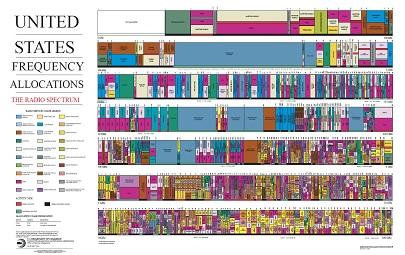The Spectrum Crunch

United States Frequency Allocations
They were first called “Hertzian waves,” a nod to their discoverer, Heinrich Rudolf Hertz, who in the 1880s demonstrated the existence of what we now know as radio waves. By 1901, Guglielmo Marconi was experimenting with the transmission of Morse code from Cornwall, England to St. Johns, Canada. He was, at the time, one of the rare users of the vast shared commons known as the electromagnetic spectrum.
While Marconi never quite answered the question of over what frequency he broadcast that code, 500 kilohertz is a good guess. It didn’t particularly matter. He could have bounced from 500 kHz to 900 kHz, or even 2,000 times that, up to 1.8 gigahertz. His cow, so to speak, was the only animal in the commons.
How things have changed. Today, in the United States, the band from 495 kHz to 505 kHz is reserved for mobile distress and calling. The 505 kHz to 510 kHz band goes to maritime mobile; from 510 kHz to 525 kHz, it’s maritime mobile and aeronautical navigation. AM radio resides in the 535 kHz-to-1605 kHz band. And so it goes, the commons crammed shoulder-to-shoulder through frequencies more than 500,000 times higher.
Users have proliferated beyond Marconi’s wildest dreams, from spacecraft to smartphones to machines talking to other machines. The efficient, productive use of spectrum has become a growing national priority. In a 2010 memorandum President Obama said, “America's future competitiveness and global technology leadership depend, in part, upon the availability of additional spectrum. The world is going wireless, and we must not fall behind.”
He described the wireless broadband revolution as “the next transformation in information technology,” one that would “trigger the creation of innovative new businesses, provide cost-effective connections in rural areas, increase productivity, improve public safety, and allow for the development of mobile telemedicine, telework, distance learning, and other new applications that will transform Americans' lives.” He underscored the importance of spectrum for current and future governmental activities, including emergency communications, national security, law enforcement, aviation, maritime, and space communications, among others.
All this demand has created a spectrum crunch, and one that, without decisive action, will only get worse: a major wireless hardware provider has predicted that global mobile data traffic will increase ten times from 2014 to 2019, a compound annual growth rate of 57 percent. The estimated 7.4 billion mobile-connected devices now exceed the number of people on Earth, and those devices continue to proliferate.
Such projections are already being reflected in the market. A U.S. government auction that wrapped up in January 2015 sold licenses for 1,611 bundles of spectrum in the band surrounding 1.8 GHz for more than $40 billion. Major wireless telecoms were the big buyers, and they spent four times what the U.S. Federal Communications Commission, which ran the auction, had anticipated. As a way of explanation, the FCC chairman paraphrased Will Rogers: “I’m putting all my money in land, because I understand they ain’t making it no more.”
Yet it’s expected to be years before all that precious spectrum frees up so the companies can use it. That’s because the frequencies in question, technically known as the AWS-3 band, have been used by the U.S. Department of Defense (DoD). The military uses it in such areas as missile guidance systems and drone training programs. They won’t be vacating until they’re sure their operations can continue without interference from commercial users.
NIST’s Communications Technology Laboratory (CTL) is working to provide the measurement science to help the DoD with this transition. More broadly, the spectrum crunch is a driving force behind all CTL programs. Accommodating future wireless-demand growth will take creativity, technological sophistication, and collaboration among government and civilian entities to maximize our collective use of finite radio waves.
There are two main ways of unlocking spectrum capacity. One is to develop systems smart enough to allow increasing numbers of users to share the same frequency bands. Another is to build the foundations for next-generation wireless systems, known as 5G that more effectively use spectrum. While still in the conceptual stages, 5G wireless will use combinations of handset-to-handset and traditional handset-to-tower communications, short-range/high-density cells, directional antennas, and new frequencies far higher than those commonly employed by today’s 4G LTE networks, among other strategies.
NIST’s CTL is playing a vital role in enabling all this. The lab is working on multiple fronts to develop measurements, tests and standards for antennas and communications systems that are intelligent, fast and nimble enough to support spectrum sharing, next-generation 5G wireless, and other means of ensuring the best and highest uses of the electromagnetic commons, now and in the future.

